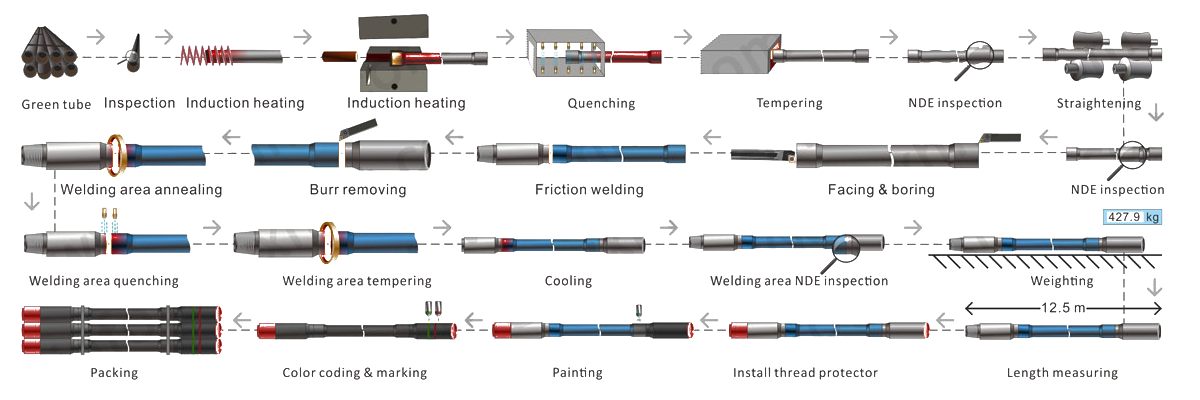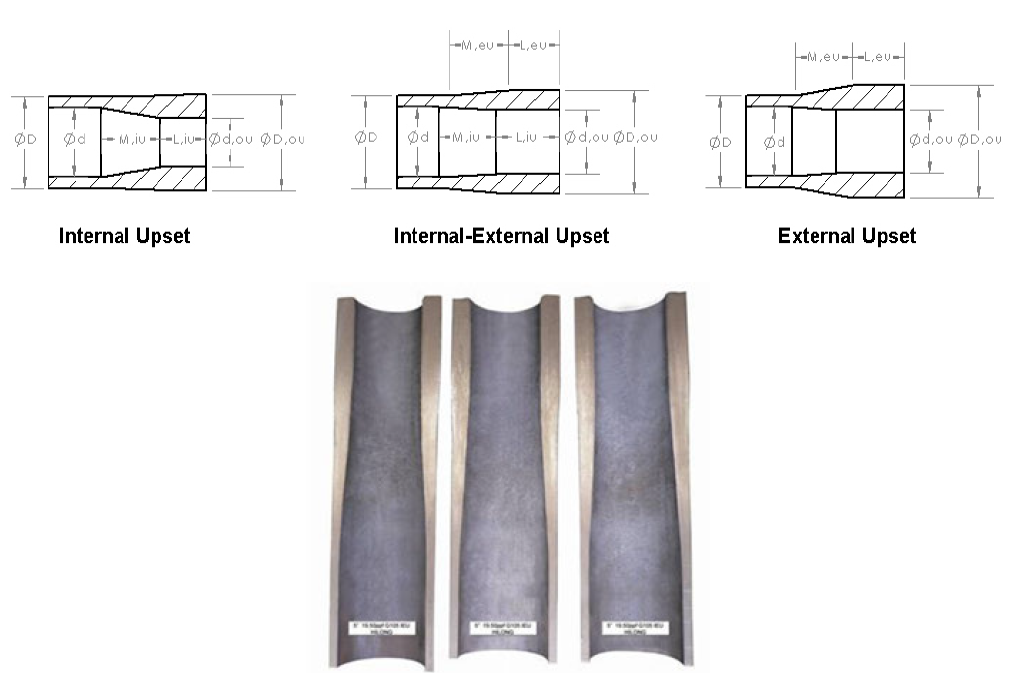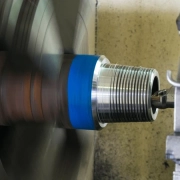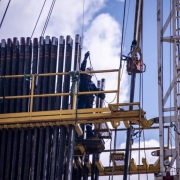API 사양 5DP 드릴 파이프: 포괄적인 가이드
소개 API 사양 5DP 드릴 파이프
드릴 파이프는 석유 및 가스 산업에서 중요한 구성 요소로, 드릴링 작업의 중추를 형성합니다. 이 파이프는 드릴링 장비를 드릴 비트에 연결하여 전력과 드릴링 유체를 전달하여 지구 표면에 시추공을 만듭니다. 이 블로그에서는 API 사양 5DP 드릴 파이프에 대한 자세한 탐색을 제공하며, 여기에는 제조 공정, 유형, 연결, 등급 등이 포함됩니다. 목표는 드릴 파이프를 효과적으로 사용하는 복잡성을 탐색하는 데 도움이 되는 실질적인 지식과 솔루션을 제공하는 것입니다.
무엇인가요 API 사양 5DP 드릴 파이프?
드릴 파이프는 무겁고, 이음매 없는, 중공 튜브로, 드릴링 작업 중에 드릴 비트를 회전시키고 드릴링 유체를 순환시킵니다. 비틀림, 장력, 압력을 포함한 상당한 응력을 견디도록 설계되었으며, 장비를 쉽게 다룰 수 있을 만큼 가볍습니다.
드릴 파이프의 중요한 기능:
- 전력 전송: 드릴 파이프는 드릴링 장비의 회전 운동을 드릴 비트로 전달합니다.
- 드릴링 유체의 순환: 이러한 장치는 드릴링 진흙이 순환하도록 하여 비트를 냉각시키고, 절삭물을 표면으로 옮기고, 시추공을 안정화합니다.
- 드릴 스트링 길이 늘리기: 굴착이 진행됨에 따라 더 깊은 곳에 도달하기 위해 굴착 스트링에 추가적인 굴착 파이프 섹션이 추가됩니다.
API 사양 5DP 드릴 파이프 제조 공정
드릴 파이프 제조는 최종 제품이 드릴링 작업에 필요한 엄격한 표준을 충족하도록 설계된 엄격하게 관리되는 공정입니다.

드릴 파이프 제조 공정
1. 재료 선택
- 고품질 강철: 이 과정은 일반적으로 강도와 인성이 높은 것으로 알려진 AISI 4130이나 4140과 같은 합금강인 고급 강철을 선택하는 것으로 시작됩니다.
- 화학적 구성 요소: 강철의 구성은 마모, 피로, 내부식성 등 원하는 기계적 특성을 달성하기 위해 신중하게 제어됩니다.
2. 파이프 성형
- 원활한 제조: 강철을 가열하고 구멍을 뚫어 중공 튜브를 만든 다음, 이 튜브를 길게 늘이고 압연하여 드릴 파이프 본체를 형성합니다.
- 용접(선택): 특정 유형의 경우, 강판을 압연하고 용접하여 파이프를 만들기도 합니다.
3. 열처리
- 담금질 및 템퍼링: 파이프는 열처리를 거쳐 기계적 성질이 향상되고, 드릴링 시 발생하는 혹독한 환경에도 견딜 수 있게 됩니다.
4. 화나게 하다
- 최종 업세팅: 파이프의 끝은 강도를 높이기 위해 두껍게 만들어집니다. 업세팅이라고 알려진 이 공정은 연결부에서 파이프의 내구성을 향상시키는 데 필수적입니다.
5. 공구 조인트 용접
- 도구 조인트 부착: 공구 조인트는 파이프 끝에 용접되어 드릴 스트링의 각 섹션을 연결하는 연결부를 형성합니다.
6. 하드밴딩
- 내마모성 코팅: 내마모성 합금을 도구 조인트에 적용하여 마모로부터 보호하고 파이프의 사용 수명을 연장합니다.
7. 검사 및 테스트
- 비파괴 검사: 각 드릴 파이프는 결함이 없는지 확인하기 위해 초음파 및 자기 입자 검사를 포함한 엄격한 테스트를 거칩니다.
- 치수 검사: 파이프는 필요한 사양을 충족하도록 측정됩니다.
8. 마킹 및 코팅
- 신분증: 각 파이프에는 등급, 크기, 제조사 등 필수 정보가 표시되어 있습니다.
- 보호 코팅: 운송 및 보관 중 파이프를 보호하기 위해 부식 방지 코팅이 파이프에 적용됩니다.
API 사양 5DP 드릴 파이프 유형
드릴 파이프에는 여러 종류가 있으며, 각각 특정 용도에 맞게 설계되었습니다.
1. 표준 드릴 파이프
- 설명: 표준 드릴링 작업에 가장 일반적으로 사용되는 드릴 파이프 유형입니다.
- 애플리케이션: 육지 및 해상 환경에서의 기존 굴착에 적합합니다.
2. 중량 드릴 파이프(HWDP)
- 설명: HWDP는 표준 드릴 파이프보다 두껍고 무겁기 때문에 드릴 스트링의 무게를 늘려 좌굴을 줄이고 안정성을 향상시키도록 설계되었습니다.
- 애플리케이션: 방향성 굴착 및 확장된 도달 범위의 우물에 이상적입니다.
3. 스파이럴 드릴 파이프
- 설명: 이 유형은 드릴링 중 마찰과 마모를 줄여주는 나선형 홈이 특징입니다.
- 애플리케이션: 마찰 감소가 중요한 작업에 사용됩니다.
4. 사각 드릴 파이프
- 설명: 정사각형 단면을 가진 덜 흔한 유형으로, 강성이 더 높습니다.
- 애플리케이션: 단단한 드릴 스트링이 필요한 특정 드릴링 시나리오에 사용됩니다.
5. 육각형 드릴 파이프
- 설명: 사각형 드릴 파이프와 비슷하지만 육각형 단면을 가지고 있어 비틀림 강도가 강화되었습니다.
- 애플리케이션: 높은 토크의 드릴링 작업에 적합합니다.
API 사양 5DP 드릴 파이프의 최종 프로세스는 무엇입니까?
드릴 파이프의 맥락에서 용어 아이유, 유럽 연합, 그리고 국제이주기구(IEU) 드릴 파이프의 끝을 연결하기 위해 준비하는 다양한 최종 공정을 말합니다. 이러한 공정은 드릴 파이프 끝이 내구성이 있고, 적절하게 정렬되어 있으며, 드릴 스트링의 다른 구성 요소에 나사산을 만들고 연결하는 데 적합한지 확인하는 데 중요합니다.

드릴 파이프 끝의 IU EU IEU
1. 내부적 혼란 (IU)
- 설명: 내부 업셋(IU) 공정에서는 파이프의 내부 직경이 줄어들어 파이프 끝부분의 벽이 두꺼워집니다.
- 목적: 이렇게 두꺼워지면 파이프 끝단의 강도가 높아져 드릴링 작업 중 발생하는 응력과 마모에 더 잘 견딥니다.
- 애플리케이션: IU 파이프는 드릴 파이프의 내부 직경이 중요한 상황, 즉 일관된 보어를 유지하는 것이 필수적인 고압 드릴링 작업에 사용됩니다.
2. 외부적 충격(EU)
- 설명: 외부 업셋(EU)은 파이프 끝의 외부 직경에서 파이프 벽의 두께를 늘리는 것을 포함합니다.
- 목적: 이 과정은 파이프 끝단을 강화하고 내구성을 향상시킵니다. 특히 드릴 파이프가 마모와 충격을 받을 가능성이 가장 높은 부분의 내구성이 향상됩니다.
- 애플리케이션: EU 드릴 파이프는 일반적으로 외부 강도와 충격 저항성이 우선시되는 표준 드릴링 작업에 사용됩니다.
3. 내부-외부 분노(IEU)
- 설명: 내부-외부 업셋(IEU)은 내부 및 외부 업셋을 결합한 것으로, 파이프 끝부분이 내부와 외부 모두 두꺼워집니다.
- 목적: 이 이중 증점 공정은 드릴 파이프 끝부분에 최대 강도와 내구성을 제공하여 내부 및 외부 힘에 대한 저항력을 향상시킵니다.
- 애플리케이션: IEU 파이프는 일반적으로 깊은 우물, 고압 시나리오, 방향성 시추 등 내부 및 외부 보강이 필요한 더 까다로운 시추 환경에서 사용됩니다.
API 사양 5DP 드릴 파이프 도구 조인트의 연결
드릴 파이프 섹션 간의 연결은 드릴 스트링의 무결성을 유지하는 데 중요합니다. API 5DP 드릴 파이프는 다양한 유형의 연결을 제공합니다.
1. 내부 플러시(IF) 연결
- 설명: 압력 강하와 난류를 최소화하기 위해 플러시 내부 프로필로 설계되었습니다.
- 애플리케이션: 고압 드릴링 환경에서 사용됩니다.
2. 풀 홀(FH) 연결
- 설명: 더 큰 구경을 통해 유체의 흐름을 개선하여 깊은 우물에 적합합니다.
- 애플리케이션: 깊은 드릴링 작업에 이상적입니다.
3. API 정규(API REG) 연결
- 설명: 견고성과 사용 편의성으로 유명한 표준 연결 유형입니다.
- 애플리케이션: 일반적으로 표준 드릴링 작업에 사용됩니다.
4. 수치 연결 (NC)
- 설명: 높은 토크 용량을 갖춘 프리미엄 연결 장치로, 종종 더블 숄더 디자인이 특징입니다.
- 애플리케이션: 까다로운 드릴링 조건에 적합합니다.
API 사양 5DP 드릴 파이프의 핀과 상자는 무엇입니까?
핀과 상자 드릴 파이프 연결의 두 보완적인 끝을 말하며, 이를 통해 파이프 섹션을 드릴링 스트링으로 안전하게 연결할 수 있습니다. 이 연결 시스템은 드릴링 작업 중 드릴 스트링의 무결성과 안정성을 유지하는 데 중요합니다.
핀
- 설명: 핀은 연결의 수컷 끝입니다. 테이퍼형이고 나사산이 있어서 상자에 나사로 고정할 수 있습니다.
- 설계: 핀의 외부 나사산은 상자의 내부 나사산과 일치하도록 정밀하게 절단되어 단단하고 안전한 고정을 보장합니다.
- 기능: 핀은 상자에 단단히 연결되어 드릴링 중에 발생하는 높은 압력, 비틀림 힘, 진동을 견딜 수 있는 견고하고 누출 방지 조인트를 형성하도록 설계되었습니다.
상자
- 설명: 상자는 연결의 암컷 끝입니다. 또한 핀을 수용하기 위해 내부에 나사산이 있습니다.
- 설계: 박스의 내부 나사산은 핀의 나사산과 일치하도록 정밀하게 가공되어 안전하고 단단한 연결이 가능합니다.
- 기능: 상자는 핀을 수용하여 튼튼한 연결을 형성하여 드릴링 작업 중 드릴 파이프 섹션이 연결되고 정렬된 상태를 유지하도록 합니다.
핀 및 박스 연결의 중요성
- 구조적 무결성: 핀과 박스 연결은 드릴 파이프 섹션이 안전하게 고정되어 드릴 스트링의 구조적 무결성이 유지되도록 보장합니다.
- 압력 저항성: 이러한 연결부는 드릴링 유체 순환으로 인해 발생하는 높은 내부 압력을 견디도록 설계되었습니다.
- 사용 편의성: 핀과 박스 연결은 조립과 분해가 쉽도록 설계되어 드릴 스트링을 빠르게 변경하고 조정할 수 있습니다.
응용
- 드릴 파이프: 핀과 박스 연결은 표준 파이프, 중량 파이프, 특수 파이프를 포함한 모든 드릴 파이프에 사용됩니다.
- 도구 조인트: 이러한 연결은 드릴 파이프의 두껍고 무거운 부분인 도구 조인트에도 사용되어 강도와 내구성을 더해줍니다.
등급, 직경, 길이 범위 및 응용 프로그램
드릴 파이프는 다양한 등급, 직경 및 길이로 제공되며 각각 다른 드릴링 환경에 적합합니다.
등급
- E-75: 일반적인 드릴링 작업에 주로 사용됩니다.
- X-95: 더 높은 강도를 제공하며 깊은 우물에 적합합니다.
- G-105: 뛰어난 피로 저항성을 갖추고 있어 장거리 드릴링에 이상적입니다.
- S-135: 가장 높은 강도 등급으로, 매우 깊은 곳과 고압 시추공에 사용됩니다.
직경과 길이
- 직경: 일반적으로 2 3/8″에서 6 5/8″까지입니다.
- 길이: 길이는 27~31피트까지이며, 프로젝트 필요에 따라 맞춤 길이도 가능합니다.
학년별 지원서
- E-75: 표준 조건에서의 해상 굴착.
- X-95: 중간 정도의 압력을 가진 깊은 우물.
- G-105: 확장된 도달 범위의 우물과 고토크 시추.
- S-135: 매우 깊고, 고압, 고온의 시추공.
포장, 보관, 유지 관리 및 운송
드릴 파이프를 올바르게 취급하는 것은 파이프의 무결성을 유지하고 사용 수명을 연장하는 데 매우 중요합니다.
포장
- 번들링: 드릴 파이프는 일반적으로 함께 묶여 있어 취급 및 운반이 편리합니다.
- 보호 캡: 드릴 파이프의 양쪽 끝에는 나사산이 손상되는 것을 방지하기 위한 보호 캡이 장착되어 있습니다.
저장
- 실내 보관: 가능하다면 드릴 파이프를 실내에 보관하여 날씨로부터 보호하는 것이 좋습니다.
- 높은 저장 공간: 파이프는 습기 및 오염 물질과의 접촉을 방지하기 위해 지면에서 떨어진 선반에 보관해야 합니다.
유지
- 정기 검사: 드릴 파이프는 마모, 부식 또는 손상 징후가 있는지 정기적으로 검사해야 합니다.
- 다시 스레딩: 나사산이 손상된 경우 다시 잘라서 연결이 안전하게 유지되도록 해야 합니다.
운송
- 안전한 로딩: 드릴 파이프는 운송 중 움직이지 않도록 트럭이나 트레일러에 안전하게 적재해야 합니다.
- 크래들 사용: 파이프는 구부러지거나 손상되는 것을 방지하기 위해 크래들을 사용하여 운반해야 합니다.
결론
API 사양 5DP 드릴 파이프는 석유 및 가스 추출 중에 발생하는 혹독한 조건을 견디도록 설계된 드릴링 작업의 중요한 구성 요소입니다. 드릴 파이프의 제조 공정, 유형, 연결, 등급 및 취급을 이해하는 것은 성능을 최적화하고 안전하고 효율적인 드릴링 작업을 보장하는 데 필수적입니다.
드릴 파이프를 선택하고, 보관하고, 유지하는 모범 사례를 따르면, 운영자는 장비 수명을 연장하고, 운영 비용을 절감하고, 고장 위험을 최소화할 수 있습니다. 이 포괄적인 가이드는 드릴링 산업의 전문가에게 귀중한 리소스로, 드릴 파이프와 관련된 과제에 대한 실질적인 통찰력과 솔루션을 제공합니다.




